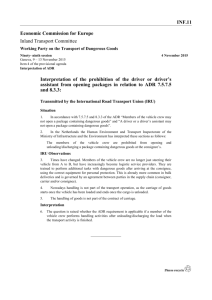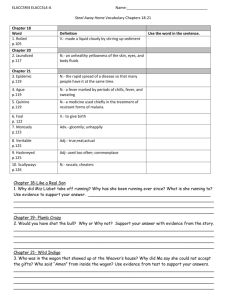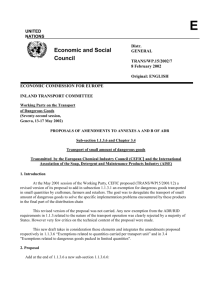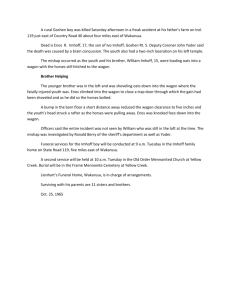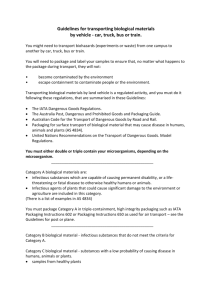Position Dutch delegation on additional measures for tank
advertisement
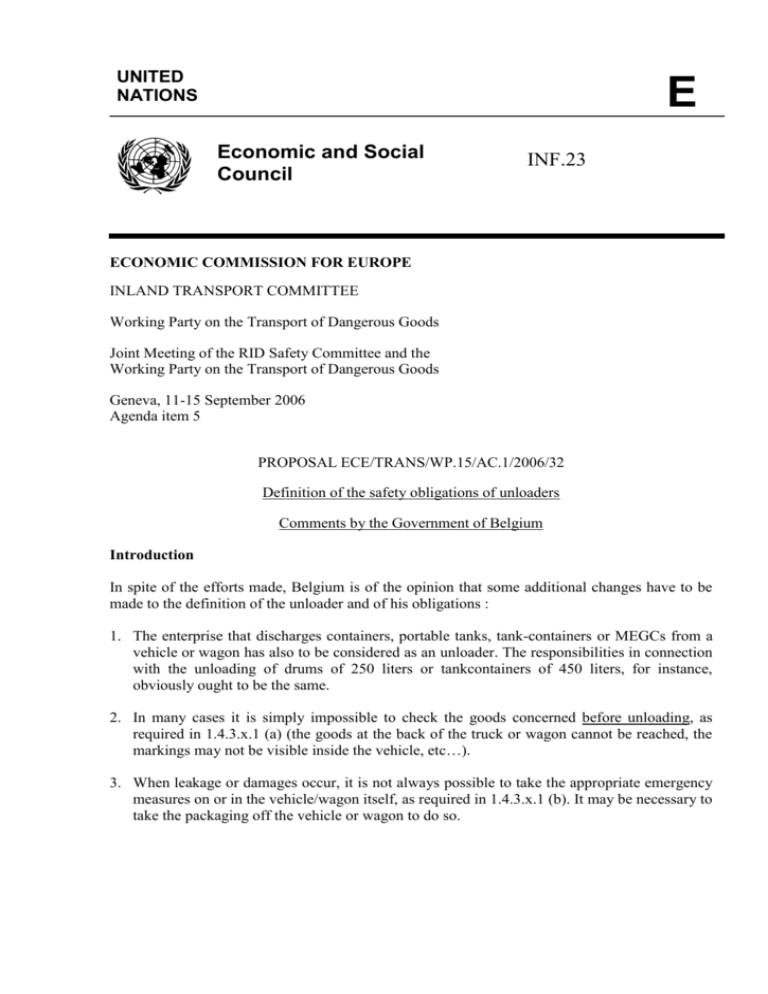
UNITED NATIONS E Economic and Social Council INF.23 ECONOMIC COMMISSION FOR EUROPE INLAND TRANSPORT COMMITTEE Working Party on the Transport of Dangerous Goods Joint Meeting of the RID Safety Committee and the Working Party on the Transport of Dangerous Goods Geneva, 11-15 September 2006 Agenda item 5 PROPOSAL ECE/TRANS/WP.15/AC.1/2006/32 Definition of the safety obligations of unloaders Comments by the Government of Belgium Introduction In spite of the efforts made, Belgium is of the opinion that some additional changes have to be made to the definition of the unloader and of his obligations : 1. The enterprise that discharges containers, portable tanks, tank-containers or MEGCs from a vehicle or wagon has also to be considered as an unloader. The responsibilities in connection with the unloading of drums of 250 liters or tankcontainers of 450 liters, for instance, obviously ought to be the same. 2. In many cases it is simply impossible to check the goods concerned before unloading, as required in 1.4.3.x.1 (a) (the goods at the back of the truck or wagon cannot be reached, the markings may not be visible inside the vehicle, etc…). 3. When leakage or damages occur, it is not always possible to take the appropriate emergency measures on or in the vehicle/wagon itself, as required in 1.4.3.x.1 (b). It may be necessary to take the packaging off the vehicle or wagon to do so. INF.23 Page 2 4. From other parts of RID/ADR (e.g. 4.3.2.4.1) it is clear that only dangerous residues have to be envisaged in 1.4.3.x.1 (d). Moreover, the residues on the inside of the vehicle/wagon or container have to be removed too ; the limitation to the outside is only valid for tanks. 5. Danger markings conforming to Chapter 5.3 may have to be removed from the wagons/vehicles, containers or tanks even when they are not completely unloaded (if they also carry non-dangerous goods, for instance). 6. Paragraph 1.4.3.x.2 referred previously to1.4.3.x.1 (a), a paragraph that no longer exists. It now refers to 1.4.3.x.1 (d) and (e), but that cannot be correct. Perhaps is is better eliminated. These changes have been introduced in the proposal below, together with some editorial corrections. Proposals 1. Add a new definition in paragraph 1.2.1 : ““Unloader” means any enterprise which : - unloads packaged dangerous goods from a vehicle/wagon or a large container, or - unloads containers, portable tanks, tank-containers or MEGCs with dangerous goods from a vehicle/wagon, or - discharges dangerous goods from a tank (tank-vehicle/tank-wagon, demountable tank, portable tank, or tank-container ) or from a , battery-vehicle/battery-wagon or MEGC), and/or - discharges dangerous goods carried in bulk from a vehicle/wagon , large container or small container for carriage in bulk “ 2. Add a new paragraph 1.4.3.x : “1.4.3.x Unloader 1.4.3.x.1 In the context of 1.4.1, the unloader shall in particular: (a) check, before unloading, documentation; the good(s) concerned and its (their) (b) when unloading the packed dangerous goods or uncleaned empty packagings, check whether the packagings may cause a any leakage of the dangerous substance(s) carried occurs or whether they packagings have been damaged to an extent which would endanger the unloading operation. In these instances the unloading shall not be carried out until the he shall take appropriate emergency measures to nullify any hazard have been taken; INF.23 page 3 (c) immediately following the discharging of the tank, vehicle/wagon or container : (i) clean remove any dangerous residues which have impregnated or soiled the vehicle/wagon or container or the outside of the tank during the process of discharging; (ii) ensure the closure of valves and inspection openings; (iii) carry out in the cases provided for by RID/ADR the prescribed cleaning and decontamination of the wagons/vehicles or containers; (iv) ensure that the wagons/vehicles, containers or tanks, once completely unloaded, cleaned and decontaminated, no longer bear danger markings conforming to Chapter 5.3 are removed if they are no longer required by RID/ADR. 1.4.3.x.2 The unloader may, however, in the case of 1.4.3.x.1 (d) and (e), rely on information and data made available to him by other participants. 1.4.3.x.2 If the unloader makes use of the services of other participants (cleaner, decontamination facility, etc.) he shall take appropriate measures to ensure that the requirements of RID/ADR have been complied with.” 3. Paragraph 1.4.2.3 shall read as follows: "1.4.2.3 The consignee has the obligation not to defer acceptance of the goods without compelling reasons. A <RID only: wagon or> container may only be returned or reused once the requirements of the ADR/RID concerning the unloader have been complied with." ----------
